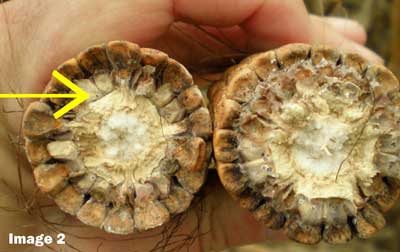- Diplodia ear rot is caused by species of Stenocarpella.
- Identifying characteristics of Diplodia include a white mold at the base of the ear and small black circular fungal bodies on the husk, kernel, or stalk.
- Diplodia infection is favored by wet conditions at silking, with further development favored by a wet fall and tight husks.
- Prioritize harvest of infected fields to prevent further disease development.
Diplodia (Stenocarpella) is a fungal pathogen that survives the winter on infected crop residue or grain. With favorable temperature and moisture conditions, pycnidia on the residue release spores in a gelatinous mass. Rain splashes the spores onto the corn plant. Corn is most susceptible to Diplodia for a period of time two weeks either side of mid-silk. During this time, spores deposited at the level of the ear leaf and at the base of the developing corn ear infect the corn plant and ear at those sites. Wet conditions during silking promote infection. Diplodia infections typically move from the base of the ear, upward, and from the cob, outward into the kernels. Continued wet conditions during fall delay harvest and provide the environment and time for further disease development.
Diplodia ear infection symptoms range from minor discoloration of affected kernels, to "mummification" of the corn ear as mycelium creates a dense mat over the surface of underdeveloped ears, causing the husks to adhere to the ear. Early symptoms of Diplodia infection may include indistinct dark blotches on leaf sheaths and the green husks, ranging to early death and browning of the husks. Infected ears may be partially or completely covered with white mycelium. Depending on rainfall and overall moisture, some ears may display little mycelial growth but infected kernels turn dark and may easily slough off the cob.
Inoculum levels of Diplodia ear rot are dependent on the amount of corn residue on the soil surface. Crop rotation will reduce the amount of pathogen present. Diplodia ear rot can be reduced with tillage of crop residue, given due consideration for offsetting impacts of soil erosion. In addition, it may be helpful to avoid planting hybrids with proven susceptibility to this disease. Hybrid risk factors include tight husks and generally upright ears later into the season. Fungicides have shown inconsistent results in reducing Diplodia ear rot, but the timing of fungicides for foliar disease management nicely coincides with the Diplodia infection period at silking. A key for more consistent fungicidal control of Diplodia may be higher carrier volumes and directed nozzles for better placement of the fungicide at the point of infection (base of the ear). Respiration inhibitors may improve overall plant health to the extent that the plant is better positioned to fend off ear infections. Infected fields should be prioritized for early harvest to prevent further development of the disease. Careful consideration should be given to storage of grain, as the disease can continue to develop in the bin under improper storage conditions (warm and wet).
Contact your FS Crop Specialist for your agronomic information.
Image 1: Diplodia ear rot at base of corn ear. (Source: GROWMARK, Inc. 2017)
Image 2: Diplodia-infected ear cross-section showing circular black fruiting bodies and brown kernels. (Source: GROWMARK, Inc.)
